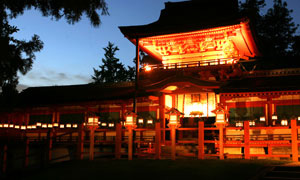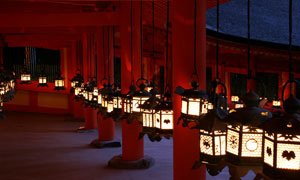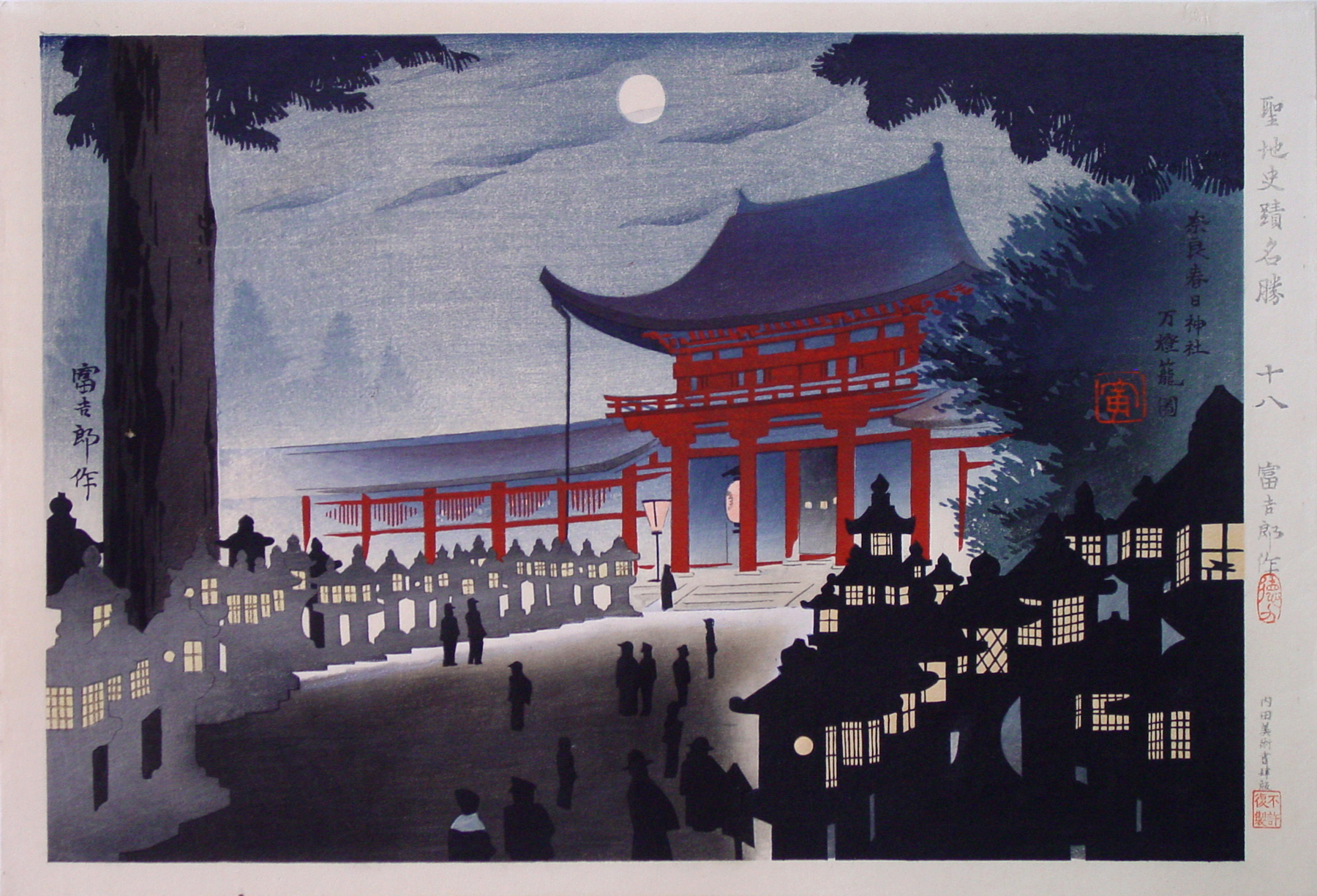About This Print
Print number eighteen in the fifty print series Scenes of Sacred and Historic Places (Seichi Shiseki Meisho) published by Uchida Woodblock Printing Company in 1941. Tokuriki has given us a view of Kasuga Taisha during the three days a year when all the lanterns in the shrine compound are lit. The full moon glows through the evening mist.The Series - Scenes of Sacred and Historic Places
The print artist Tokuriki and the publisher Unsōdō created two series of prints to mark Kigen 2600, or the 2600th year of Japan's mythical founding as a nation. The first, a paean to Mount Fuji, a sacred site of pilgrimage and worship, titled Thirty-Six Views of Mount Fuji, harkened back to Hokusai’s famous 1831 series of the same name. The second series, Scenes of Sacred and Historic Places, capitalized on the nationalist ideology that Japan was a divine land, presenting overtly nationalistic landscapes including shrines, temples, castles, places associated with the divine origins of Japan, Meiji era history and samurai
culture.
In his commentary on this series, the artist wrote that his devotion to these sites is intended to demonstrate to the people the dignity of the national polity, going on to say that he advocates prints as a means of providing comfort and pleasure to the wholesome citizens of the nation.
This series was extremely popular with domestic and foreign buyers who purchased one thousand copies within a short time after issuance.1 I imagine that foreign buyers were enchanted by the lovely scenes with much of the import of each print escaping them. In the 1950s, six prints from this series were re-printed under the title The Album of Famous Views of Japan and eight additional prints were re-printed under the title The Eight Views of Japan. Later printings omit the information in the margin and some position the artist's signature and print title within the image in a different location from the original issue.
For images of all the prints in the series, go to the website of Ross Walker's Ohmi Gallery at http://www.ohmigallery.com/Gallery/Tokuriki/SacredPlaces.htm.
1 Modern Japanese Woodblock Prints - The Early Years, Helen Merritt, University of Hawaii Press, 1998, p. 89.
In his commentary on this series, the artist wrote that his devotion to these sites is intended to demonstrate to the people the dignity of the national polity, going on to say that he advocates prints as a means of providing comfort and pleasure to the wholesome citizens of the nation.
For images of all the prints in the series, go to the website of Ross Walker's Ohmi Gallery at http://www.ohmigallery.com/Gallery/Tokuriki/SacredPlaces.htm.
1 Modern Japanese Woodblock Prints - The Early Years, Helen Merritt, University of Hawaii Press, 1998, p. 89.
Margin Annotations of Original Edition (top to bottom) and Print Title Within Image
 series title Seichi Shiseki Meishō 聖地 史蹟 名勝 |  十八 (18) |  Tomikichiro Saku 富吉郎 作 (Made by Tomikichiro) followed by oval seal1 |  内田美術書肆版 (Uchida Fine Art Shop) followed in seal form by Fukyo Fukusei (Reproduction forbidden) | Print Title  奈良春日神社 万燈籠圖 (Illustration of Kasuga Shrine in Nara during the Lantern Festival) |
1 possibly a reproduction of an old censor's seal
The title of each print appears within the image area along with the artist's signature and seal (which also appears in the right margin.) The artist's signature is comprised of the artist's name 富吉郎 (Tomikichirō) either by itself or followed by the single kanji character 作 (saku "made by"), as shown below, or by the character 謹 (kin "respectfully") followed by 作.

Kasuga Shrine
Established in 768 AD as the shrine of the powerful Fujiwara clan it has been rebuilt several times over the centuries.Setsubun Mantoro (Lantern Festival) 節分万燈籠
Source: Japan National Tourism Association website http://www.jnto.go.jp/eng/indepth/history/traditionalevents/a09_fes_setsubun.html
At Kasuga Taisha Shrine in Nara, each of the more than 3,000 lanterns in the precincts are lit up three days a year, namely on February 3rd and August 14th-15th, between 18:30 and 21:00. This is an event which has continued for 800 years and most of the lanterns have been donated by ordinary citizens with the exception of a handful which had been dedicated by samurai warriors in the Warring States Period. Such scenery lit only by candlelight takes you back into bygone days of no electricity and is full of mysticism. The reflections of the light on the river surface and the vermilion buildings of the shrine strike a beautiful harmony.
There are stone lanterns in the gardens and hanging lanterns in the corridors. The garden lanterns are decorated with strips of Japanese paper inscribed with people's wishes, and are lit by the participants. The hanging lanterns in the corridors come in a variety of designs. It appears that the number of lanterns corresponds to the number of wishes. Formerly, these numerous lanterns were lit up every night, which is quite amazing.
 |  |
Print Details
| IHL Catalog | #439 |
| Title | Illustration of Kasuga Shrine in Nara during the Lantern Festival 奈良春日神社 万燈籠圖 |
| Series | Scenes of Sacred and Historic Places (also seen translated as "Collected Prints of Sacred, Historic and Scenic Places") 聖地 史蹟 名勝 Seichi Shiseki Meisho |
| Artist | Tokuriki Tomikichirō (1902-2000) |
| Signature | Tomikichirō saku (富吉郎 作) |
| Seal |  |
| Date | September 1941 |
| Edition | original (first) edition |
| Publisher | Uchida Bijutsu Shoten |
| Impression | excellent |
| Colors | excellent |
| Condition | excellent - minor residue top corners verso from previous folio mounting |
| Genre | shin hanga (new print) |
| Miscellaneous | 十八 #18 in series |
| Format | horizontal oban |
| H x W Paper | 11 1/4 x 16 1/4 in. (28.6 x 41.3 cm) |
| H x W Image | 10 3/8 x 15 in. (26.4 x 38.1 cm) |
| Collections This Print | Penn Libraries, Rare Book & Manuscript Library - Rare Book Collection Call no.: Portfolio NE1325.T65 A4 1940 |
| Reference Literature | |


